[TOC]
# 簡介
公司在自己的局域網內搭建自己的遠程倉庫服務器,稱為私服,私服服務器即是公司內部的 maven 遠程倉庫,每個員工的電腦上安裝 maven 軟件并且連接私服服務器,員工將自 己開發的項目打成 jar 并發布到私服服務器,其它項目組從私服服務器下載所依賴的構件 (jar)。
私服還充當一個代理服務器,當私服上沒有 jar 包會從互聯網中央倉庫自動下載,如下 圖:
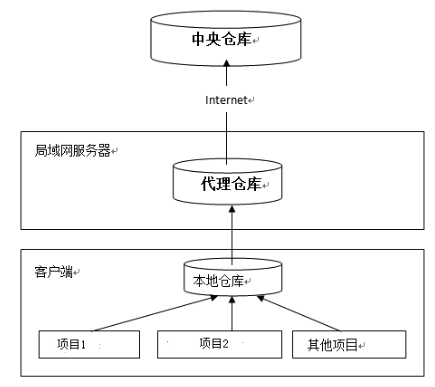
下載 Nexus, 下載地址:http://www.sonatype.org/nexus/archived/
[https://help.sonatype.com/repomanager3/download](https://help.sonatype.com/repomanager3/download)
windows要
cmd 進入 bin 目錄,執行 `nexus.bat install`
cmd 進入 bin 目錄,執行 `nexus.bat start`
# 配置文件
nexus.properties是配置文件
~~~
# Jetty section
application-port=8081 # nexus 的訪問端口配置
application-host=0.0.0.0 # nexus 主機監聽配置(不用修改)
nexus-webapp=${bundleBasedir}/nexus # nexus 工程目錄
nexus-webapp-context-path=/nexus # nexus 的 web 訪問路徑
# Nexus section
nexus-work=${bundleBasedir}/../sonatype-work/nexus # nexus 倉庫目錄 runtime=${bundleBasedir}/nexus/WEB-INF # nexus 運行程序目錄
~~~
wrapper.conf這個文件下面改下java的這個
~~~
wrapper.java.command=/Library/Java/JavaVirtualMachines/jdk1.8.0_202.jdk/Contents/Home/bin/java
~~~
默認密碼
admin和admin123
[http://127.0.0.1:8081/nexus](http://127.0.0.1:8081/nexus)
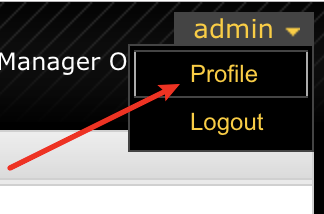
這個里面可以改密碼
# 倉庫類型
nexus 的倉庫有 4 種類型:
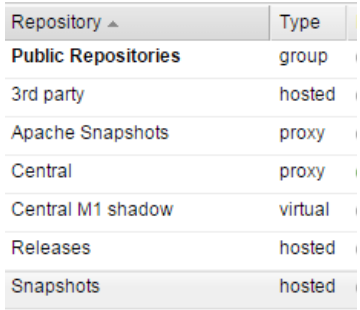
1. hosted,宿主倉庫,部署自己的 jar 到這個類型的倉庫,包括 releases 和 snapshot 兩部 分,Releases公司內部發布版本倉庫、 Snapshots 公司內部測試版本倉庫
2. proxy,代理倉庫,用于代理遠程的公共倉庫,如 maven 中央倉庫,用戶連接私服,私服自動去中央倉庫下載 jar 包或者插件。
3. group,倉庫組,用來合并多個 hosted/proxy 倉庫,通常我們配置自己的 maven 連接倉庫組。
4. virtual(虛擬):兼容Maven1 版本的jar或者插件
nexus 倉庫默認在 sonatype-work 目錄中:
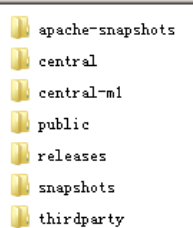
* central:代理倉庫,代理中央倉庫
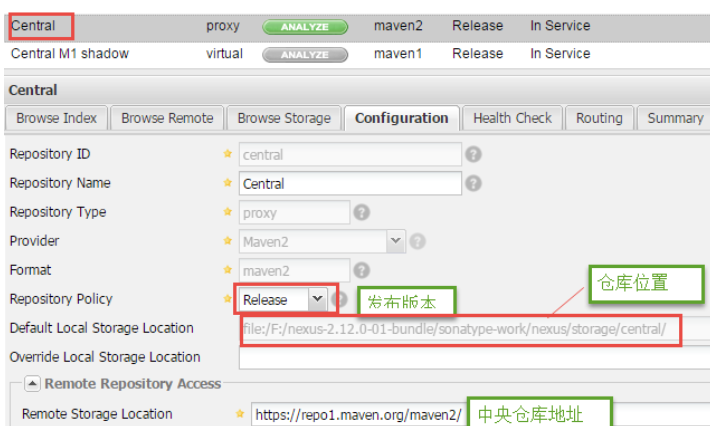
* apache-snapshots:代理倉庫
存儲 snapshots 構件,代理地址 https://repository.apache.org/snapshots/ ? central-m1:virtual 類型倉庫,兼容 Maven1 版本的 jar 或者插件 ? releases:本地倉庫,存儲releases構件。
* snapshots:本地倉庫,存儲snapshots構件。
* thirdparty:第三方倉庫
* public:倉庫組
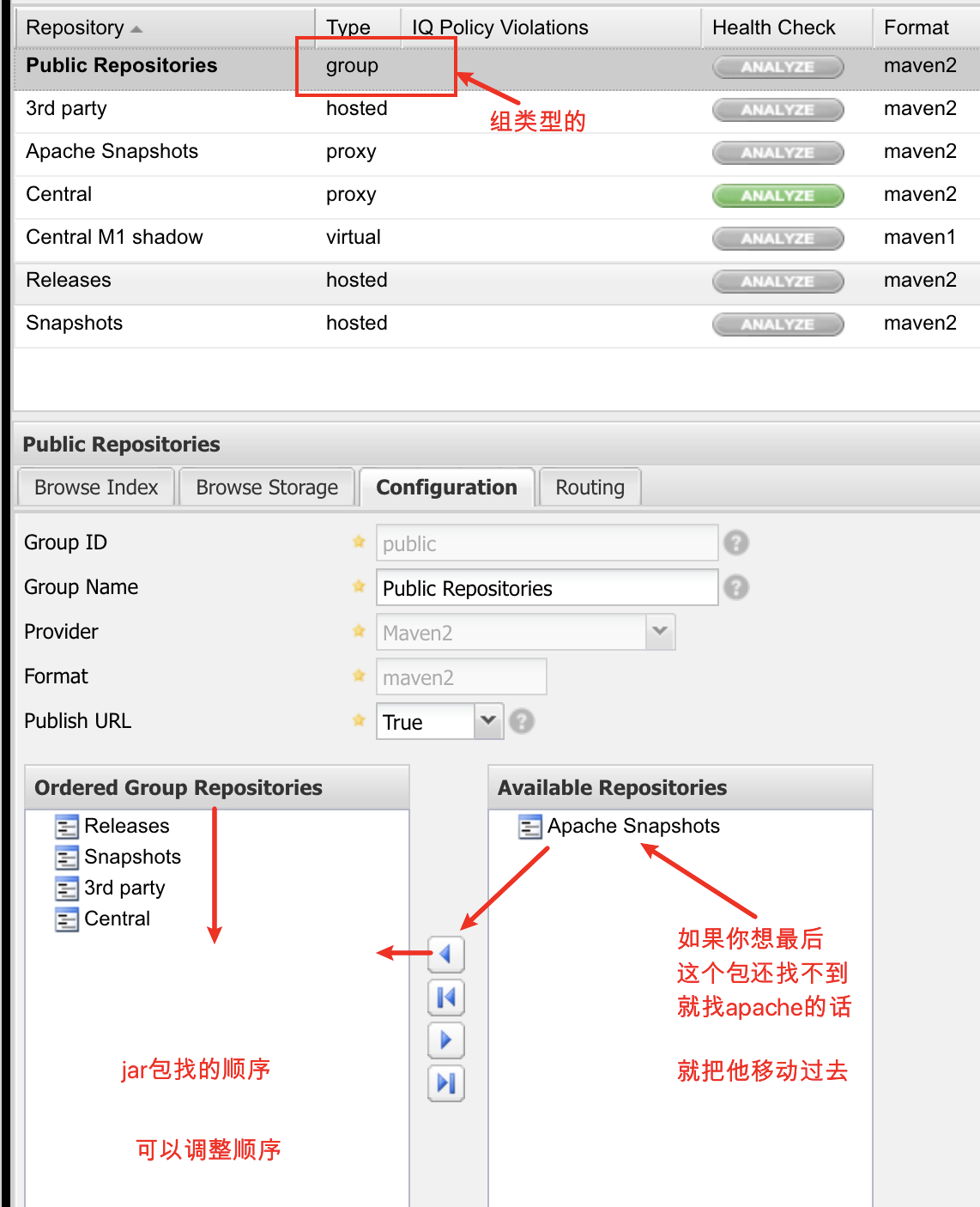
# 發布到私服
## 需求
企業中多個團隊協作開發通常會將一些公用的組件、開發模塊等發布到私服供其它團隊 或模塊開發人員使用。
本例子假設多團隊分別開發 ssm\_dao、ssm\_service、ssm\_web,某個團隊開發完在 ssm\_dao 會將 ssm\_dao 發布到私服供 ssm\_service 團隊使用,本例子會將 ssm\_dao 工程打成 jar 包發布到私服。

## 配置
第一步:需要在客戶端即部署ssm\_dao工程的電腦上配置 maven環境,并修改 settings.xml 文件,配置連接私服的用戶和密碼 。
此用戶名和密碼用于私服校驗,因為私服需要知道上傳的賬號和密碼是否和私服中的賬號和 密碼一致。
~~~
<server>
<id>releases</id>
<username>admin</username>
<password>admin123</password>
</server>
<server>
<id>snapshots</id>
<username>admin</username>
<password>admin123</password>
</server>
~~~
releases 連接發布版本項目倉庫
snapshots 連接測試版本項目倉庫

第二步: 配置項目 pom.xml
配置私服倉庫的地址,本公司的自己的 jar 包會上傳到私服的宿主倉庫,根據工程的版本號 決定上傳到哪個宿主倉庫,如果版本為 release 則上傳到私服的 release 倉庫,如果版本為 snapshot 則上傳到私服的 snapshot 倉庫
url是私服網頁上的對應倉庫的url

~~~
<distributionManagement>
<repository>
<id>releases</id>
<name>Nexus Release Repository</name>
<url>http://localhost:8081/nexus/content/repositories/releases/</url>
</repository>
<snapshotRepository>
<id>snapshots</id>
<name>Nexus Snapshot Repository</name>
<url>http://localhost:8081/nexus/content/repositories/snapshots/</url>
</snapshotRepository>
</distributionManagement>
~~~
注意:pom.xml 這里 和 settings.xml 配置對應
你要在dao中把包上傳就在dao中deploy的
根據本項目 pom.xml 中 version 定義決定發布到哪個倉庫,
如果 version 定義為 snapshot, 執行 deploy 后查看 nexus 的 snapshot 倉庫,
如果 version 定義為 release 則項目將發布到 nexus 的 release 倉庫,本項目將發布到 release 倉庫.
**測試**
可以通過 http 方式查看

# 從私服下載jar包
## 需求
沒有配置 nexus 之前,如果本地倉庫沒有,去中央倉庫下載,通常在企業中會在局域網 內部署一臺私服服務器,有了私服本地項目首先去本地倉庫找 jar,
如果沒有找到則連接私 服從私服下載 jar 包,如果私服沒有 jar 包私服同時作為代理服務器從中央倉庫下載 jar 包,
這樣做的好處是一方面由私服對公司項目的依賴 jar 包統一管理,一方面提高下載速度,項 目連接私服下載 jar 包的速度要比項目連接中央倉庫的速度快的多。
**在 setting.xml 中配置倉庫**
在客戶端的 setting.xml 中配置私服的倉庫,由于 setting.xml 中沒有 repositories 的配置
標簽需要使用 profile 定義倉庫。
~~~
<profile>
<!--profile 的 id-->
<id>dev</id>
<repositories>
<repository>
<!--倉庫 id,repositories 可以配置多個倉庫,保證 id 不重復-->
<id>nexus</id>
<!--倉庫地址,即 nexus 倉庫組的地址-->
<url>http://localhost:8081/nexus/content/groups/public/</url>
<!--是否下載 releases 構件-->
<releases>
<enabled>true</enabled>
</releases>
<!--是否下載 snapshots 構件-->
<snapshots>
<enabled>true</enabled>
</snapshots>
</repository>
</repositories>
<pluginRepositories>
<!-- 插件倉庫,maven 的運行依賴插件,也需要從私服下載插件 -->
<pluginRepository>
<!-- 插件倉庫的 id 不允許重復,如果重復后邊配置會覆蓋前邊 -->
<id>public</id>
<name>Public Repositories</name>
<url>http://localhost:8081/nexus/content/groups/public/</url>
</pluginRepository>
</pluginRepositories>
</profile>
~~~
使用 profile 定義倉庫需要激活才可生效
~~~
<activeProfiles>
<activeProfile>dev</activeProfile>
</activeProfiles>
~~~
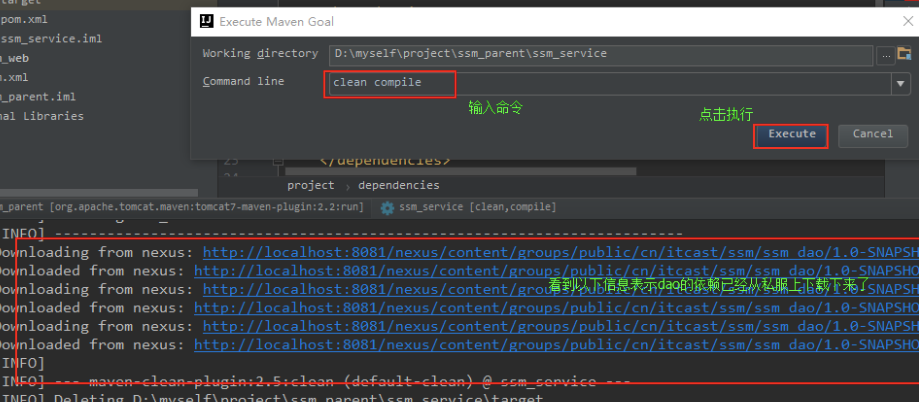
# 第三方jar包安裝到本地或私服
1. 導入本地庫
2種方式
~~~
----進入jar包所在目錄運行
mvn install:install-file -DgroupId=com.alibaba -DartifactId=fastjson -Dversion=1.1.37 -Dfile=fastjson-1.1.37.jar -Dpackaging=jar
----打開cmd直接運行
mvn install:install-file -DgroupId=com.alibaba -DartifactId=fastjson -Dversion=1.1.37 -Dpackaging=jar -Dfile=C:\my_java\fastjson-1.1.37.jar
~~~
然后去倉庫看下
2. 導入私服
需要在 maven 軟件的核心配置文件 settings.xml 中配置第三方倉庫的 server 信息
要能登錄到第三方
~~~
<server>
<id>thirdparty</id>
<username>admin</username>
<password>admin123</password>
</server>
~~~
才能執行一下命令
2種方式
~~~
----進入jar包所在目錄運行
mvn deploy:deploy-file -DgroupId=com.alibaba -DartifactId=fastjson -Dversion=1.1.37 -Dpackaging=jar -Dfile=fastjson-1.1.37.jar -Durl=http://localhost:8081/nexus/content/repositories/thirdparty/ -DrepositoryId=thirdparty
----打開cmd直接運行
mvn deploy:deploy-file -DgroupId=com.alibaba -DartifactId=fastjson -Dversion=1.1.37 -Dpackaging=jar -Dfile=C:\my_java\fastjson-1.1.37.jar -Durl=http://localhost:8081/nexus/content/repositories/thirdparty/ -DrepositoryId=thirdparty
~~~
**參數說明**
DgroupId 和 DartifactId 構成了該 jar 包在 pom.xml 的坐標,項目就是依靠這兩個屬性定位。 自己起名字也行。
Dfile 表示需要上傳的 jar 包的絕對路徑。
Durl 私服上倉庫的位置,打開 `nexus——>repositories` 菜單,可以看到該路徑。
DrepositoryId 服務器的表示 id,在 nexus 的 configuration 可以看到。
Dversion 表示版本信息,
**關于 jar 包準確的版本: **
包的名字上一般會帶版本號,如果沒有那可以解壓該包,會發現一個叫 MANIFEST.MF 的文件,
這個文件就有描述該包的版本信息。
比如 Specification-Version: 2.2 可以知道該包的版本了。
上傳成功后,在 nexus 界面點擊 3rd party 倉庫可以看到這包。
# 多個私服切換
setting.xml 家和公司兩套
activeProfiles屬性指定id
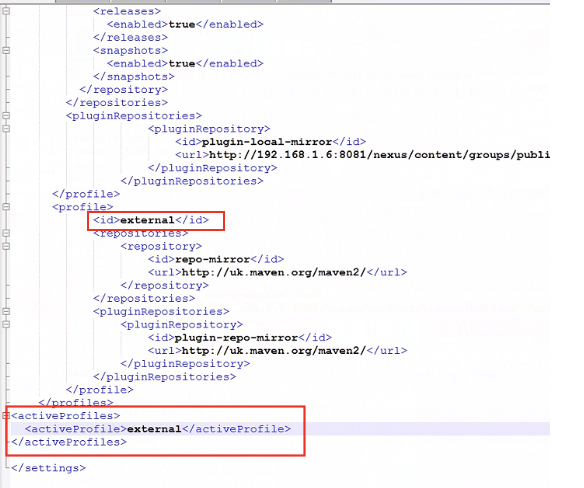
# nexus3界面
> Repository:倉儲系統
* Blob Stores:這個可以看成是存儲空間,管理空間,主要是進行管理Repositorles中倉庫的,默認有一個default存儲,可以創建存儲空間
* Reposltorles:倉庫,這就是我們所說的倉庫的概念了,倉庫一共分為三種類型,宿主(hosted),代理(proxy)和分組(group)
* 宿主:第三方構建所能上傳的倉庫,可以創建多個name屬性不同的宿主倉庫,用于管理不同的項目
* 代理:訪問網絡nexus服務器,用途:打個比方的說,想使用Junit包,但是分組倉庫中沒有,就需要去訪問網絡上的中央倉庫中下載到你的代理倉庫.(因為實際從網絡倉庫中download的是代理倉庫,ps:默認訪問網絡中倉庫的是游客,這個無需去計較了!)
* 分組:分組倉庫的主要作用就是將你的宿主倉庫和代理倉庫進行連接,比如說不同的項目創建的不通的宿主倉庫,卻使用了相同的代理倉庫.這種就可以使用分組倉庫進行連接!!!!!!!
* Content Selectors:未知,不了解.從大概的意思上就是nexus組件的使用,和創建自己的組件
> Security:安全管理,賬號的權限,SSL證書的配置都在這里
* Prlvileges:每種倉庫的增刪改查,瀏覽等權限,可以單獨進行配置,被使用于Roles
* Roles:角色權限,相當于一個權限模板,提供給User使用!默認有兩種權限,一個是游客(anonymous),一個是管理員(admin)
* Users:用戶,這個就是訪問nexus私服的用戶了,默認同樣是有兩個,一個是管理員(admin),一個是游客(anonymous),管理員繼承了Roles中admin權限模板,具有所有管理權限,而游客只有瀏覽權限
* Anonymous:游客(或者叫匿名用戶) 請忽略他
* LDAP:通訊錄? 不了解,請忽略他
* Realms:領域?什么領域? 不了解,請忽略他
* SSL Certlficates:SSL證書配置
> Support:支持,分析系統運行狀態,系統信息,日志查看都在這里
* Analytlcs:分析你的組組件在如何的使用Nexus
* Logging:系統各項組件日志
* Metrlcs:內存,線程,磁盤目前使用圖
* Support ZIP:選擇Support中各種分析文件打成ZIP文件,其中包括系統的運行狀態啊,JVM啊,配置文件啊,日志啊等等之類的!
* System InforMation:系統信息,這個比較常用,可以看Nexus運行狀態,版本信息,配置文件,組件信息等..... -- System:系統設置
* Bundles:系統插件具體信息的查看,我是這么理解的!有問題,請留言!
* Capabilities:管理和配置你的Nexus具有什么能力,正常使用默認的就好!
* Email Server:Email服務的配置,用于發郵件(在系統出現問題時)
* HTTP: 整體傳輸協議的配置,默認的就好!
* Licensing:許可證配置,SSL許可證?
* Recent Connections:7天內訪問系統信息,都誰訪問過nexus服務器
* Nodes:節點管理?
* Tasks:系統任務
## 倉庫創建
登錄管理界面Administration->Repository->Repositories->左上角Create repository(創建倉庫)
我們創建一個Maven2類型的宿主(hosted)倉庫(Maven2(hosted)),以下步驟下圖所示
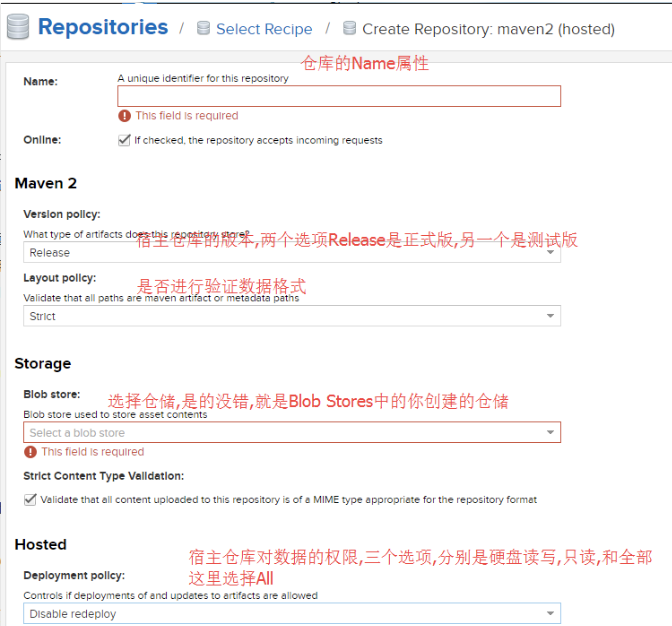
上圖提到了Storage倉儲的這點,那么下圖就去創建一個倉儲,倉儲是可以創建多個的,每個倉儲可以存儲不通類型倉庫的數據\_ 創建倉儲:Repository->Blob Stores->Create blob store,下圖所示
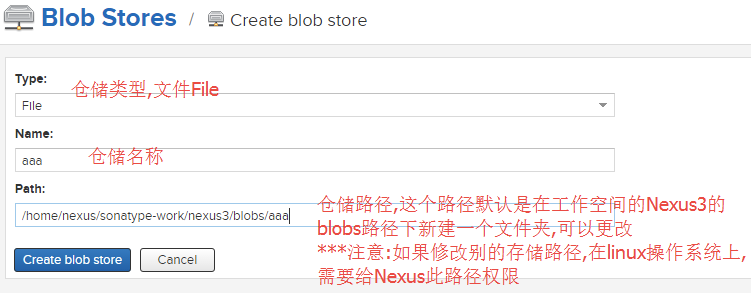
創建步驟重述:先創建倉儲,在創建倉庫,創建倉庫時選擇你創建的倉儲,就可以了(一個倉庫只能選擇一個倉儲)
## 權限管理
Nexus的權限控制采用的是典型的權限(Privilege)和角色(Role)機制。角色與權限是一對多的關聯,用戶與角色也是一對多的關聯。由于Nexus的主要功能就是管理Maven倉庫,所以其權限(Privilege)主要是對倉庫進行CRUD(增查改刪)操作的權限。作為Nexus的用戶,我們能進行管理的就是對倉庫的增刪改查權限,其他的例如UI權限等是Nexus內建的,用戶無法增刪改,這個在下一節會講到。
單個權限(Privilege)所能控制的級別是一個倉庫(Repository,包括Group)中存儲路徑匹配指定正則表達式的一組項目(Artifact)的增刪查改(create,delete,read,update)中的某一個操作。正因為其使用了正則表達式來選定要控制的Artifact所以非常靈活。
Nexus的權限分為三類:
1. 應用權限(Application Privilege):主要是用戶的UI操作權限和系統管理權限,例如通過UI登錄、進行用戶管理等。
2. 倉庫目標權限(Repository Target Privilege):我們作為用戶能自定義的唯一一種權限,就是對倉庫中的項目的CRUD操作權限。
3. 倉庫瀏覽權限(Repository View Privilege):通過UI界面瀏覽一個倉庫的權限,在創建每個倉庫時,Nexus會自動創建一個對應該倉庫的View權限,擁有該倉庫的view權限才能在系統的Repositories視圖中看到該倉庫。
以上三類權限中,應用權限和倉庫瀏覽權限兩種是由Nexus創建的,我們并不能對這些權限進行增刪改操作,只能選擇使用或不使用它們。我們能自定義的權限只有倉庫目標權限
---
創建用戶:Security->Users->左上角Create user,創建詳細如圖所示:
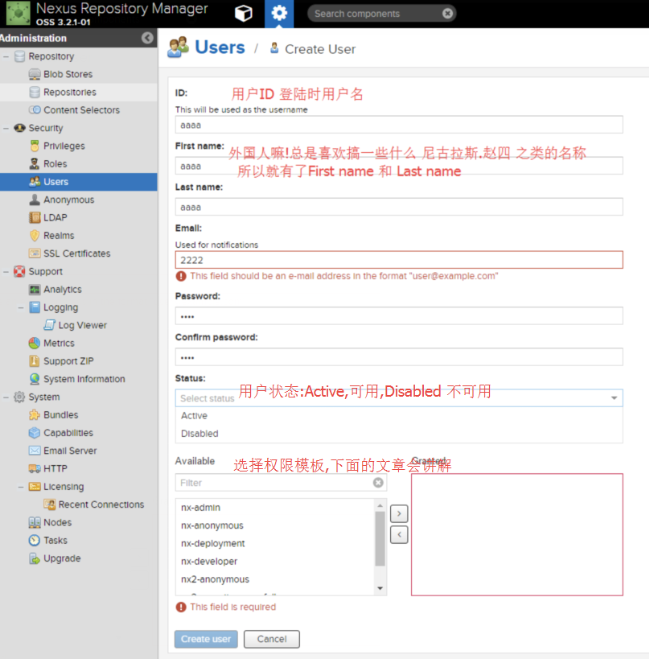
創建用戶需要一個用戶所屬的模板,可以繼承多個模板,相當于同時有了多種模板所具有權限,下面進行創建一個模板 創建角色模板:Security->Roles->Create Role->Nexus role
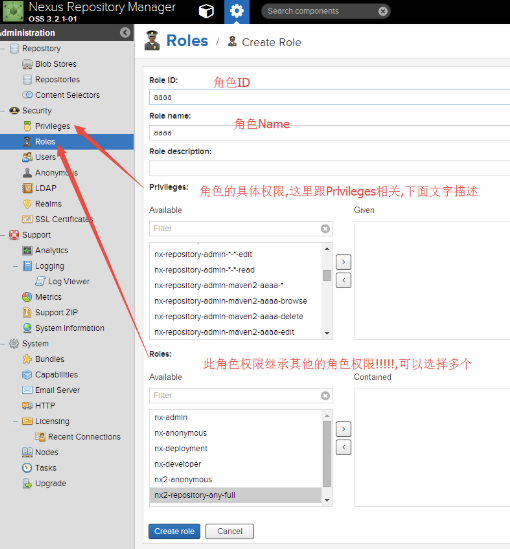
Privileges: 管理倉庫的多種權限,以一個我創建的倉庫 aaa截圖說明:
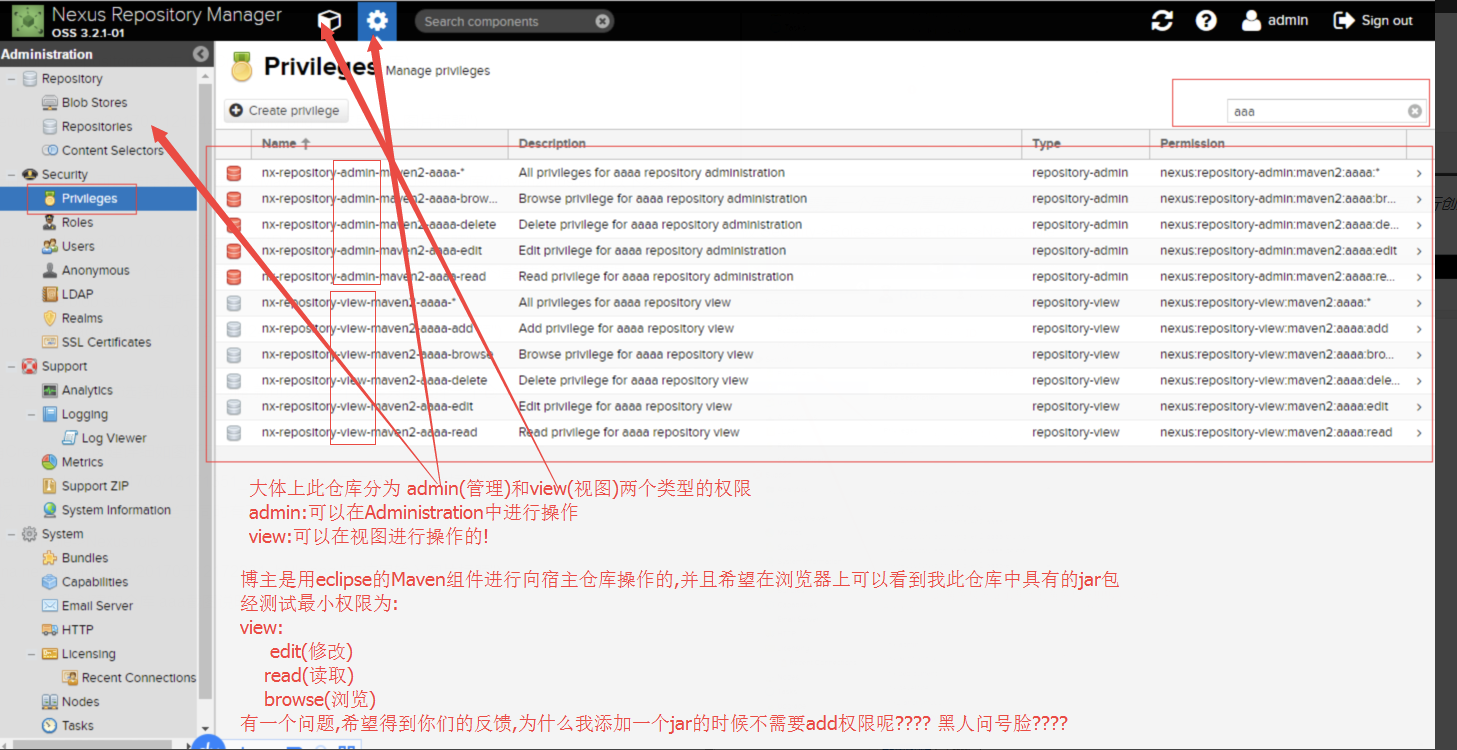
強調:權限管理步驟復述,需要先具有一個角色模板(roles),同時也需要一個Privileges(當構建倉庫的時候,默認會構建完成),之后創建User,鏈接所屬Role就可以了*
## 訪問
setting.xml
在`<mirrors></mirrors>`標簽中添加`mirror`子節點:
~~~xml
<mirror>
<id>maven-private</id>
<mirrorOf>maven-private</mirrorOf>
<url>https://repo.liming.pub/nexus/repository/maven-private/</url>
</mirror>
~~~
或者在`<prifiles></prifiles>`標簽中增加增加profile子節點:
~~~xml
<profile>
<id>maven-private</id>
<repositories>
<repository>
<id>maven-private</id>
<url>https://repo.liming.pub/nexus/repository/maven-private/</url>
<snapshots>
<updatePolicy>always</updatePolicy>
</snapshots>
</repository>
</repositories>
</profile>
~~~
在`<servers></servers>`標簽中添加`server`子節點:
~~~xml
<server>
<id>maven-private</id>
<username>用戶名</username>
<password>密碼</password>
</server>
~~~
工程pom中增加發布倉庫配置
~~~xml
<profiles>
<profile>
<id>maven-protect</id>
<distributionManagement>
<repository>
<id>maven-protect-releases</id>
<url>https://repo.liming.pub/nexus/repository/maven-protect-releases/</url>
</repository>
<repository>
<id>maven-protect-snapshots</id>
<url>https://repo.liming.pub/nexus/repository/maven-protect-snapshots/</url>
</repository>
</distributionManagement>
</profile>
<profile>
<id>maven-private</id>
<distributionManagement>
<repository>
<id>maven-private-releases</id>
<url>https://repo.liming.pub/nexus/repository/maven-private-releases/</url>
</repository>
<repository>
<id>maven-private-snapshots</id>
<url>https://repo.liming.pub/nexus/repository/maven-private-snapshots/</url>
</repository>
</distributionManagement>
</profile>
</profiles>
~~~
在setting.xml的`<servers></servers>`標簽中添加`server`子節點
~~~xml
<server>
<id>maven-private-snapshots</id>
<username>用戶名</username>
<password>密碼</password>
</server>
<server>
<id>maven-private-releases</id>
<username>用戶名</username>
<password>密碼</password>
</server>
~~~
## 部署命令
通過maven 的-P參數激活指定的profile
參數的值是profile的id,多個profile以逗號分割,如果不想激活某個默認的profile,就在它的id前加個!
~~~
mvn deploy -Pmaven-private
~~~
查看當前生效的profile:
~~~
mvn help:active-profiles -Pmaven-private
~~~
# maven離線使用
要在無網絡訪問的環境下使用maven,由于私有倉庫無法同步中央倉庫,這種情況下,可以將本地倉庫整個打包拷貝過去。注意要將各個目錄下的`_remote.repositories`文件刪除,否則maven也不會使用本地倉庫的jar。
刪除命令如下:
~~~
find ~/.m2/ -name _maven.repositories | xargs rm
~~~
- 基礎
- 編譯和安裝
- classpath到底是什么?
- 編譯運行
- 安裝
- sdkman多版本
- jabba多版本
- java字節碼查看
- 數據類型
- 簡介
- 整形
- char和int
- 變量和常量
- 大數值運算
- 基本類型包裝類
- Math類
- 內存劃分
- 位運算符
- 方法相關
- 方法重載
- 可變參數
- 方法引用
- 面向對象
- 定義
- 繼承和覆蓋
- 接口和抽象類
- 接口定義增強
- 內建函數式接口
- 多態
- 泛型
- final和static
- 內部類
- 包
- 修飾符
- 異常
- 枚舉類
- 代碼塊
- 對象克隆
- BeanUtils
- java基礎類
- scanner類
- Random類
- System類
- Runtime類
- Comparable接口
- Comparator接口
- MessageFormat類
- NumberFormat
- 數組相關
- 數組
- Arrays
- string相關
- String
- StringBuffer
- StringBuilder
- 正則
- 日期類
- Locale類
- Date
- DateFormat
- SimpleDateFormat
- Calendar
- 新時間日期API
- 簡介
- LocalDate,LocalTime,LocalDateTime
- Instant時間點
- 帶時區的日期,時間處理
- 時間間隔
- 日期時間校正器
- TimeUnit
- 用yyyy
- 集合
- 集合和迭代器
- ArrayList集合
- List
- Set
- 判斷集合唯一
- Map和Entry
- stack類
- Collections集合工具類
- Stream數據流
- foreach不能修改內部元素
- of方法
- IO
- File類
- 字節流stream
- 字符流Reader
- IO流分類
- 轉換流
- 緩沖流
- 流的操作規律
- properties
- 序列化流與反序列化流
- 打印流
- System類對IO支持
- commons-IO
- IO流總結
- NIO
- 異步與非阻塞
- IO通信
- Unix的IO模型
- epoll對于文件描述符操作模式
- 用戶空間和內核空間
- NIO與普通IO的主要區別
- Paths,Path,Files
- Buffer
- Channel
- Selector
- Pipe
- Charset
- NIO代碼
- 多線程
- 創建線程
- 線程常用方法
- 線程池相關
- 線程池概念
- ThreadPoolExecutor
- Runnable和Callable
- 常用的幾種線程池
- 線程安全
- 線程同步的幾種方法
- synchronized
- 死鎖
- lock接口
- ThreadLoad
- ReentrantLock
- 讀寫鎖
- 鎖的相關概念
- volatile
- 釋放鎖和不釋放鎖的操作
- 等待喚醒機制
- 線程狀態
- 守護線程和普通線程
- Lamda表達式
- 反射相關
- 類加載器
- 反射
- 注解
- junit注解
- 動態代理
- 網絡編程相關
- 簡介
- UDP
- TCP
- 多線程socket上傳圖片
- NIO
- JDBC相關
- JDBC
- 預處理
- 批處理
- 事務
- properties配置文件
- DBUtils
- DBCP連接池
- C3P0連接池
- 獲得MySQL自動生成的主鍵
- Optional類
- Jigsaw模塊化
- 日志相關
- JDK日志
- log4j
- logback
- xml
- tomcat
- maven
- 簡介
- 倉庫
- 目錄結構
- 常用命令
- 生命周期
- idea配置
- jar包沖突
- 依賴范圍
- 私服
- 插件
- git-commit-id-plugin
- maven-assembly-plugin
- maven-resources-plugin
- maven-compiler-plugin
- versions-maven-plugin
- maven-source-plugin
- tomcat-maven-plugin
- 多環境
- 自定義插件
- stream
- swing
- json
- jackson
- optional
- junit
- gradle
- servlet
- 配置
- ServletContext
- 生命周期
- HttpServlet
- request
- response
- 亂碼
- session和cookie
- cookie
- session
- jsp
- 簡介
- 注釋
- 方法,成員變量
- 指令
- 動作標簽
- 隱式對象
- EL
- JSTL
- javaBean
- listener監聽器
- Filter過濾器
- 圖片驗證碼
- HttpUrlConnection
- 國際化
- 文件上傳
- 文件下載
- spring
- 簡介
- Bean
- 獲取和實例化
- 屬性注入
- 自動裝配
- 繼承和依賴
- 作用域
- 使用外部屬性文件
- spel
- 前后置處理器
- 生命周期
- 掃描規則
- 整合多個配置文件
- 注解
- 簡介
- 注解分層
- 類注入
- 分層和作用域
- 初始化方法和銷毀方法
- 屬性
- 泛型注入
- Configuration配置文件
- aop
- aop的實現
- 動態代理實現
- cglib代理實現
- aop名詞
- 簡介
- aop-xml
- aop-注解
- 代理方式選擇
- jdbc
- 簡介
- JDBCTemplate
- 事務
- 整合
- junit整合
- hibernate
- 簡介
- hibernate.properties
- 實體對象三種狀態
- 檢索方式
- 簡介
- 導航對象圖檢索
- OID檢索
- HQL
- Criteria(QBC)
- Query
- 緩存
- 事務管理
- 關系映射
- 注解
- 優化
- MyBatis
- 簡介
- 入門程序
- Mapper動態代理開發
- 原始Dao開發
- Mapper接口開發
- SqlMapConfig.xml
- map映射文件
- 輸出返回map
- 輸入參數
- pojo包裝類
- 多個輸入參數
- resultMap
- 動態sql
- 關聯
- 一對一
- 一對多
- 多對多
- 整合spring
- CURD
- 占位符和sql拼接以及參數處理
- 緩存
- 延遲加載
- 注解開發
- springMVC
- 簡介
- RequestMapping
- 參數綁定
- 常用注解
- 響應
- 文件上傳
- 異常處理
- 攔截器
- springBoot
- 配置
- 熱更新
- java配置
- springboot配置
- yaml語法
- 運行
- Actuator 監控
- 多環境配置切換
- 日志
- 日志簡介
- logback和access
- 日志文件配置屬性
- 開機自啟
- aop
- 整合
- 整合Redis
- 整合Spring Data JPA
- 基本查詢
- 復雜查詢
- 多數據源的支持
- Repository分析
- JpaSpeci?cationExecutor
- 整合Junit
- 整合mybatis
- 常用注解
- 基本操作
- 通用mapper
- 動態sql
- 關聯映射
- 使用xml
- spring容器
- 整合druid
- 整合郵件
- 整合fastjson
- 整合swagger
- 整合JDBC
- 整合spingboot-cache
- 請求
- restful
- 攔截器
- 常用注解
- 參數校驗
- 自定義filter
- websocket
- 響應
- 異常錯誤處理
- 文件下載
- 常用注解
- 頁面
- Thymeleaf組件
- 基本對象
- 內嵌對象
- 上傳文件
- 單元測試
- 模擬請求測試
- 集成測試
- 源碼解析
- 自動配置原理
- 啟動流程分析
- 源碼相關鏈接
- Servlet,Filter,Listener
- springcloud
- 配置
- 父pom
- 創建子工程
- Eureka
- Hystrix
- Ribbon
- Feign
- Zuul
- kotlin
- 基本數據類型
- 函數
- 區間
- 區塊鏈
- 簡介
- linux
- ulimit修改
- 防止syn攻擊
- centos7部署bbr
- debain9開啟bbr
- mysql
- 隔離性
- sql執行加載順序
- 7種join
- explain
- 索引失效和優化
- 表連接優化
- orderby的filesort問題
- 慢查詢
- show profile
- 全局查詢日志
- 死鎖解決
- sql
- 主從
- IDEA
- mac快捷鍵
- 美化界面
- 斷點調試
- 重構
- springboot-devtools熱部署
- IDEA進行JAR打包
- 導入jar包
- ProjectStructure
- toString添加json模板
- 配置maven
- Lombok插件
- rest client
- 文檔顯示
- sftp文件同步
- 書簽
- 代碼查看和搜索
- postfix
- live template
- git
- 文件頭注釋
- JRebel
- 離線模式
- xRebel
- github
- 連接mysql
- 選項沒有Java class的解決方法
- 擴展
- 項目配置和web部署
- 前端開發
- json和Inject language
- idea內存和cpu變高
- 相關設置
- 設計模式
- 單例模式
- 簡介
- 責任鏈
- JUC
- 原子類
- 原子類簡介
- 基本類型原子類
- 數組類型原子類
- 引用類型原子類
- JVM
- JVM規范內存解析
- 對象的創建和結構
- 垃圾回收
- 內存分配策略
- 備注
- 虛擬機工具
- 內存模型
- 同步八種操作
- 內存區域大小參數設置
- happens-before
- web service
- tomcat
- HTTPS
- nginx
- 變量
- 運算符
- 模塊
- Rewrite規則
- Netty
- netty為什么沒用AIO
- 基本組件
- 源碼解讀
- 簡單的socket例子
- 準備netty
- netty服務端啟動
- 案例一:發送字符串
- 案例二:發送對象
- websocket
- ActiveMQ
- JMS
- 安裝
- 生產者-消費者代碼
- 整合springboot
- kafka
- 簡介
- 安裝
- 圖形化界面
- 生產過程分析
- 保存消息分析
- 消費過程分析
- 命令行
- 生產者
- 消費者
- 攔截器interceptor
- partition
- kafka為什么快
- kafka streams
- kafka與flume整合
- RabbitMQ
- AMQP
- 整體架構
- RabbitMQ安裝
- rpm方式安裝
- 命令行和管控頁面
- 消息生產與消費
- 整合springboot
- 依賴和配置
- 簡單測試
- 多方測試
- 對象支持
- Topic Exchange模式
- Fanout Exchange訂閱
- 消息確認
- java client
- RabbitAdmin和RabbitTemplate
- 兩者簡介
- RabbitmqAdmin
- RabbitTemplate
- SimpleMessageListenerContainer
- MessageListenerAdapter
- MessageConverter
- 詳解
- Jackson2JsonMessageConverter
- ContentTypeDelegatingMessageConverter
- lucene
- 簡介
- 入門程序
- luke查看索引
- 分析器
- 索引庫維護
- elasticsearch
- 配置
- 插件
- head插件
- ik分詞插件
- 常用術語
- Mapping映射
- 數據類型
- 屬性方法
- Dynamic Mapping
- Index Template 索引模板
- 管理映射
- 建立映射
- 索引操作
- 單模式下CURD
- mget多個文檔
- 批量操作
- 版本控制
- 基本查詢
- Filter過濾
- 組合查詢
- 分析器
- redis
- String
- list
- hash
- set
- sortedset
- 發布訂閱
- 事務
- 連接池
- 管道
- 分布式可重入鎖
- 配置文件翻譯
- 持久化
- RDB
- AOF
- 總結
- Lettuce
- zookeeper
- zookeeper簡介
- 集群部署
- Observer模式
- 核心工作機制
- zk命令行操作
- zk客戶端API
- 感知服務動態上下線
- 分布式共享鎖
- 原理
- zab協議
- 兩階段提交協議
- 三階段提交協議
- Paxos協議
- ZAB協議
- hadoop
- 簡介
- hadoop安裝
- 集群安裝
- 單機安裝
- linux編譯hadoop
- 添加新節點
- 退役舊節點
- 集群間數據拷貝
- 歸檔
- 快照管理
- 回收站
- 檢查hdfs健康狀態
- 安全模式
- hdfs簡介
- hdfs命令行操作
- 常見問題匯總
- hdfs客戶端操作
- mapreduce工作機制
- 案例-單詞統計
- 局部聚合Combiner
- combiner流程
- combiner案例
- 自定義排序
- 自定義Bean對象
- 排序的分類
- 案例-按總量排序需求
- 一次性完成統計和排序
- 分區
- 分區簡介
- 案例-結果分區
- 多表合并
- reducer端合并
- map端合并(分布式緩存)
- 分組
- groupingComparator
- 案例-求topN
- 全局計數器
- 合并小文件
- 小文件的弊端
- CombineTextInputFormat機制
- 自定義InputFormat
- 自定義outputFormat
- 多job串聯
- 倒排索引
- 共同好友
- 串聯
- 數據壓縮
- InputFormat接口實現類
- yarn簡介
- 推測執行算法
- 本地提交到yarn
- 框架運算全流程
- 數據傾斜問題
- mapreduce的優化方案
- HA機制
- 優化
- Hive
- 安裝
- shell參數
- 數據類型
- 集合類型
- 數據庫
- DDL操作
- 創建表
- 修改表
- 分區表
- 分桶表
- DML操作
- load
- insert
- select
- export,import
- Truncate
- 注意
- 嚴格模式
- 函數
- 內置運算符
- 內置函數
- 自定義函數
- Transfrom實現
- having和where不同
- 壓縮
- 存儲
- 存儲和壓縮結合使用
- explain詳解
- 調優
- Fetch抓取
- 本地模式
- 表的優化
- GroupBy
- count(Distinct)去重統計
- 行列過濾
- 動態分區調整
- 數據傾斜
- 并行執行
- JVM重用
- 推測執行
- reduce內存和個數
- sql查詢結果作為變量(shell)
- youtube
- flume
- 簡介
- 安裝
- 常用組件
- 攔截器
- 案例
- 監聽端口到控制臺
- 采集目錄到HDFS
- 采集文件到HDFS
- 多個agent串聯
- 日志采集和匯總
- 單flume多channel,sink
- 自定義攔截器
- 高可用配置
- 使用注意
- 監控Ganglia
- sqoop
- 安裝
- 常用命令
- 數據導入
- 準備數據
- 導入數據到HDFS
- 導入關系表到HIVE
- 導入表數據子集
- 增量導入
- 數據導出
- 打包腳本
- 作業
- 原理
- azkaban
- 簡介
- 安裝
- 案例
- 簡介
- command類型單一job
- command類型多job工作流flow
- HDFS操作任務
- mapreduce任務
- hive腳本任務
- oozie
- 安裝
- hbase
- 簡介
- 系統架構
- 物理存儲
- 尋址機制
- 讀寫過程
- 安裝
- 命令行
- 基本CURD
- java api
- CURD
- CAS
- 過濾器查詢
- 建表高級屬性
- 與mapreduce結合
- 與sqoop結合
- 協處理器
- 參數配置優化
- 數據備份和恢復
- 節點管理
- 案例-點擊流
- 簡介
- HUE
- 安裝
- storm
- 簡介
- 安裝
- 集群啟動及任務過程分析
- 單詞統計
- 單詞統計(接入kafka)
- 并行度和分組
- 啟動流程分析
- ACK容錯機制
- ACK簡介
- BaseRichBolt簡單使用
- BaseBasicBolt簡單使用
- Ack工作機制
- 本地目錄樹
- zookeeper目錄樹
- 通信機制
- 案例
- 日志告警
- 工具
- YAPI
- chrome無法手動拖動安裝插件
- 時間和空間復雜度
- jenkins
- 定位cpu 100%
- 常用腳本工具
- OOM問題定位
- scala
- 編譯
- 基本語法
- 函數
- 數組常用方法
- 集合
- 并行集合
- 類
- 模式匹配
- 異常
- tuple元祖
- actor并發編程
- 柯里化
- 隱式轉換
- 泛型
- 迭代器
- 流stream
- 視圖view
- 控制抽象
- 注解
- spark
- 企業架構
- 安裝
- api開發
- mycat
- Groovy
- 基礎
